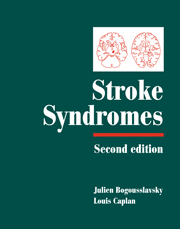Book contents
- Frontmatter
- Contents
- List of contributors
- Preface
- PART I CLINICAL MANIFESTATIONS
- 1 Stroke onset and courses
- 2 Clinical types of transient ischemic attacks
- 3 Hemiparesis and other types of motor weakness
- 4 Sensory abnormality
- 5 Cerebellar ataxia
- 6 Headache: stroke symptoms and signs
- 7 Eye movement abnormalities
- 8 Cerebral visual dysfunction
- 9 Visual symptoms (eye)
- 10 Vestibular syndromes and vertigo
- 11 Auditory disorders in stroke
- 12 Abnormal movements
- 13 Seizures and stroke
- 14 Disturbances of consciousness and sleep–wake functions
- 15 Aphasia and stroke
- 16 Agitation and delirium
- 17 Frontal lobe stroke syndromes
- 18 Memory loss
- 19 Neurobehavioural aspects of deep hemisphere stroke
- 20 Right hemisphere syndromes
- 21 Poststroke dementia
- 22 Disorders of mood behaviour
- 23 Agnosias, apraxias and callosal disconnection syndromes
- 24 Muscle, peripheral nerve and autonomic changes
- 25 Dysarthria
- 26 Dysphagia and aspiration syndromes
- 27 Respiratory dysfunction
- 28 Clinical aspects and correlates of stroke recovery
- PART II VASCULAR TOPOGRAPHIC SYNDROMES
- Index
- Plate section
7 - Eye movement abnormalities
from PART I - CLINICAL MANIFESTATIONS
Published online by Cambridge University Press: 17 May 2010
- Frontmatter
- Contents
- List of contributors
- Preface
- PART I CLINICAL MANIFESTATIONS
- 1 Stroke onset and courses
- 2 Clinical types of transient ischemic attacks
- 3 Hemiparesis and other types of motor weakness
- 4 Sensory abnormality
- 5 Cerebellar ataxia
- 6 Headache: stroke symptoms and signs
- 7 Eye movement abnormalities
- 8 Cerebral visual dysfunction
- 9 Visual symptoms (eye)
- 10 Vestibular syndromes and vertigo
- 11 Auditory disorders in stroke
- 12 Abnormal movements
- 13 Seizures and stroke
- 14 Disturbances of consciousness and sleep–wake functions
- 15 Aphasia and stroke
- 16 Agitation and delirium
- 17 Frontal lobe stroke syndromes
- 18 Memory loss
- 19 Neurobehavioural aspects of deep hemisphere stroke
- 20 Right hemisphere syndromes
- 21 Poststroke dementia
- 22 Disorders of mood behaviour
- 23 Agnosias, apraxias and callosal disconnection syndromes
- 24 Muscle, peripheral nerve and autonomic changes
- 25 Dysarthria
- 26 Dysphagia and aspiration syndromes
- 27 Respiratory dysfunction
- 28 Clinical aspects and correlates of stroke recovery
- PART II VASCULAR TOPOGRAPHIC SYNDROMES
- Index
- Plate section
Summary
Introduction
Eye movement commands originate in diverse cerebral hemispheric areas (for saccades and smooth pursuit) or in labyrinths (for the vestibular ocular reflex). They are carried out in the brainstem by the immediate premotor structures and the motor nuclei. Conjugate lateral eye movements are largely organized in the pons, and vertical eye movements and convergence in the midbrain. In the first part of this chapter, we will see the main types of eye movement paralysis resulting from brainstem lesions, and the related physiopathology. Such types of abnormalities are easily detected at bedside by studying three main types of eye movements: saccades, i.e. rapid eye movements made towards a visual target (such as the finger of the examiner); smooth pursuit, elicited by a small visual target moving slowly in front of the subject's eyes; the vestibular ocular reflex (VOR), tested using the oculocephalic movement, by moving passively the subject's head. In the second part of this chapter, eye movement disturbances due to cerebellar and cerebral hemispheric lesions, resulting in relatively more subtle syndromes, will be reviewed.
BRAINSTEM
Lateral eye movements
Final common pathway
The final common pathway of conjugate lateral eye movements begins in the abducens nucleus, which contains: (i) the motor neurones projecting onto the ipsilateral lateral rectus; and (ii) the internuclear neurones, which decussate at the level of the abducens nucleus, run through the medial longitudinal fasciculus (MLF) and project onto the medial rectus motor neurones in the contralateral oculomotor nucleus (Fig. 7.1) (for review, see Pierrot-Deseilligny, 1990 and Leigh & Zee, 1999).
- Type
- Chapter
- Information
- Stroke Syndromes , pp. 76 - 86Publisher: Cambridge University PressPrint publication year: 2001
- 5
- Cited by



